Objective 1. Create and Save a New Document
With Microsoft Word 2003, you can type, editmake changes tomove, and delete text or change the appearance of text in a document. Because the document is stored electronically, it can be duplicated, printed, copied, and shared with others. In this project, you will identify the parts of the Word window. Then you will create a document, edit and format text, and save and print your Word document.
Activity 1.1. Starting Word and Identifying Parts of the Word Window
|
1. |
On the left side of the Windows taskbar, point to and then click the Start button |
||||||||||||||||||||||||||||||
|
2. |
From the displayed Start menu, locate the Word program, and then click Microsoft Office Word 2003. Figure 1.2. 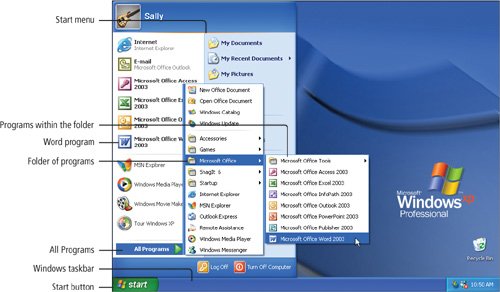
|
||||||||||||||||||||||||||||||
|
|
|||||||||||||||||||||||||||||||
|
3. |
Take a moment to study the main parts of the Word screen as shown in Figure 1.3 and described in the table in Figure 1.4. Figure 1.3. 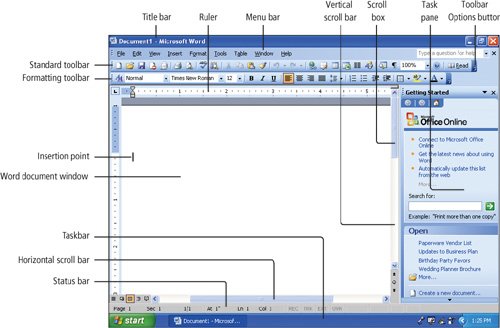
Alert!: Does Your Screen Differ? The appearance of the Word screen can vary depending on various settings that were established when Microsoft Office was installed. Additionally, whether a screen element displays sometimes depends on how the program was last used. |
||||||||||||||||||||||||||||||
|
4. |
On the Formatting toolbar, click the Toolbar Options button |
A toolbar contain buttons, each of which provide a one-click method to perform a common command. Toolbars are most useful when all of the most commonly used buttons are displayed. Most Word users keep the Standard and Formatting toolbars displayed on separate rows so that most common buttons display.
More Knowledge: Turning on Toolbars
If a toolbar is missing entirely, point to an existing toolbar or to the menu bar, and then click the right mouse button (also known as right-clicking). On the shortcut menu that displays, point to the name of the toolbar you want to display and click the left mouse button. A shortcut menu is a context-sensitive menu of commands relevant to the particular item. Alternatively, display the View menu, click Toolbars, and then click the name of the toolbar you want to display. If a toolbar is open, a check mark displays to the left of the toolbar name.
Activity 1.2. Creating a New Document
When you start the Word program, you need only to start typing to create a new document. As you work on a document, save your changes frequently.
|
1. |
On the Getting Started task pane title bar, click the small Close button |
|
2. |
If necessary, to the left of the horizontal scroll bar, click the Print Layout View button |
|
3. |
On the blue title bar, notice that Document1 displays. |
Word displays the file name of a document in both the blue title bar at the top of the screen and on a button in the taskbar at the lower edge of the screenincluding new unsaved documents. The new unsaved document displays Document followed by a number; the number depends on how many times you have started a new document during your current Word session. Compare your screen with Figure 1.5.
Figure 1.5.

Another Way: To Create a New Document
There are five ways to begin a new document in Word:
- Start the Word program; a new blank document displays.
- On the Standard toolbar, click the New Blank Document button.
- From the menu bar, click File, and then click New.
- From the Getting Started task pane, under Open, click Create a new document.
- From the New Document task pane, under New, click Blank document.
Activity 1.3. Displaying Formatting Marks
When you press  ,
,  , or
, or  on your keyboard, characters are placed in your document to represent these keystrokes. These characters do not print, and are referred to as formatting marks or nonprinting characters. Because formatting marks guide your eye in a documentlike a map and road signs guide you along a highwaythese marks will display throughout this instruction.
on your keyboard, characters are placed in your document to represent these keystrokes. These characters do not print, and are referred to as formatting marks or nonprinting characters. Because formatting marks guide your eye in a documentlike a map and road signs guide you along a highwaythese marks will display throughout this instruction.
|
1. |
In the displayed blank document, determine if a paragraph symbol (¶) displays in the upper left corner of the document, as shown in Figure 1.6. If you do not see the paragraph symbol, on the Standard toolbar, click the Show/Hide ¶ button Figure 1.6. 
Paragraph marks display at the end of every paragraph. Every time you press  , a new paragraph is created, and a paragraph mark is inserted. Paragraph marks are especially helpful in showing the number of blank lines inserted in a document. , a new paragraph is created, and a paragraph mark is inserted. Paragraph marks are especially helpful in showing the number of blank lines inserted in a document. |
|
2. |
Click the Show/Hide ¶ button |
Activity 1.4. Entering Text and Inserting Blank Lines
Business letters follow a standard format and contain the following parts: the current datethe date line; the name and address of the person receiving the letterthe inside address; a greetingthe salutation; an optional subject; the body of the letter; a closing line with a parting farewellthe complimentary closing; and the writer's identification, which includes the name or job title (or both) of the writer. Some letters also include the initials of the person who typed the letter and a list of enclosuresdocuments included with the letter. In this activity, you will begin the text of a business letter.
|
1. |
With the insertion point blinking in the upper left corner of the document to the left of the default first paragraph mark, type Sept Figure 1.7. 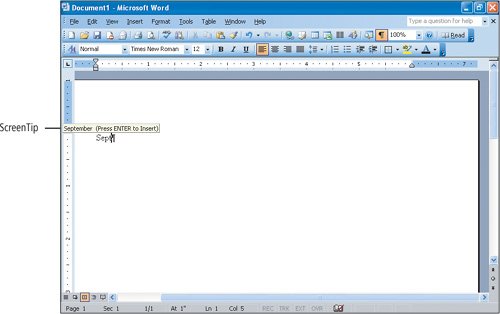
|
|
2. |
To finish the word September, press |
|
3. |
Press |
|
4. |
Type Mr. Paul Dione and then press |
|
5. |
On three lines, type the following address: Include a comma after the city name in an inside address. However, for mailing addresses on envelopes, eliminate the comma after the city name. |
|
6. |
Press |
|
7. |
Type Subject: Participation in the Planning Retreat and compare your screen with Figure 1.8. Press Figure 1.8. 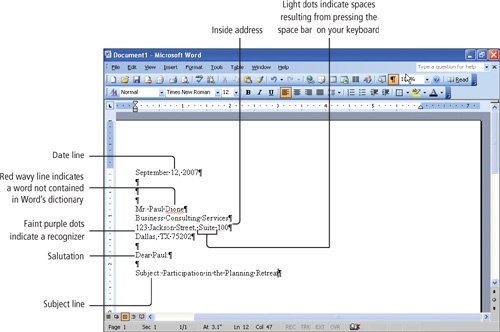
|
The subject line follows the salutation. The subject line is optional, but you should include a subject line in most letters to identify the topic. The purple dotted line under the street address is another recognizer, indicating that you could add the address to your Microsoft Outlook address book or perform other useful tasks with the address.
Activity 1.5. Creating Folders for Document Storage and Saving a Document
In the same way that you use file folders to organize your paper documents, Windows uses a hierarchy of electronic folders to keep your electronic files organized. When you save a document file, the Windows operating system stores your document permanently on a storage medium. Changes that you make to existing documents, such as changing text or typing in new text, are not permanently saved until you perform a Save operation.
|
|
|
|
1. |
Determine where you will be storing your projects from this textbook, for example, on your own disk or USB flash drive, your own hard drive, or on a network drive on a college network. Be sure that storage location is available or connected to your computer. Then, on the menu bar, click File, and then click Save As. NoteTurning On Full Menus The instruction in this textbook assumes that the full menus display when you click a menu command. To turn on full menus, go to the menu bar, click Tools, and then click Customize. In the Customize dialog box, click the Options tab, and then click the Always show full menus check box. Click the Close button to close the dialog box. |
|
2. |
In the Save As dialog box, at the right edge of the Save in box, click the Save in arrow to view a list of the drives available to you, as shown in Figure 1.9. Figure 1.9. 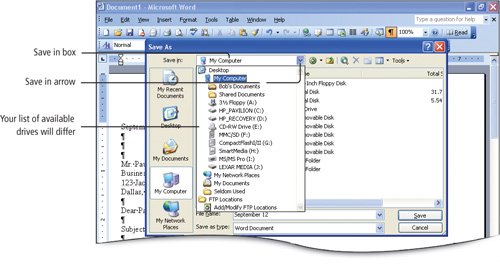
|
|
|
|
|
3. |
Navigate to the drive on which you will be storing your folders and projects for this chapterfor example, 3½ Floppy (A:), a USB flash drive that you have connected, or the drive designated by your instructor or lab coordinator. |
|
4. |
In the Save As dialog box toolbar, click the Create New Folder button Figure 1.10. 
The new folder name displays in the Save in box, indicating that the folder is open and ready to store your document. |
|
5. |
In the lower portion of the Save As dialog box, locate the File name box. If necessary, select or delete the existing text, and then in the File name box, using your own first and last name, type 1A_Thank_You_Letter_Firstname_Lastname as shown in Figure 1.11. Figure 1.11. 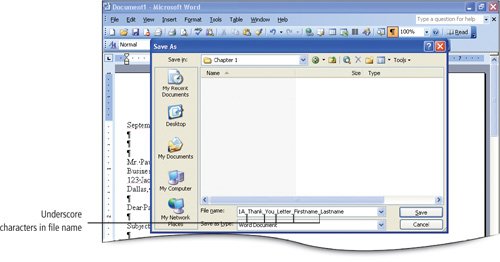
Throughout this textbook, you will be instructed to save your files using the file name followed by your first and last name. Check with your instructor to see if there is some other file naming arrangement for your course. The Microsoft Windows operating system recognizes file names with spaces. However, some Internet file transfer programs do not. To facilitate sending your files over the Internet using a course management system, in this textbook you will be instructed to save files using an underscore instead of a space. The underscore key is the shift of the  key, located two keys to the left of key, located two keys to the left of  . . |
|
6. |
In the lower portion of the Save As dialog box, click the Save button, or press |
|
7. |
As you type the following text, press the NoteSpacing Between Sentences Although you may have learned to press |
|
8. |
Type I would also like to thank you personally for taking notes and also for summarizing the ideas expressed at the retreat. |
|
9. |
Press |
|
10. |
Press Figure 1.12. 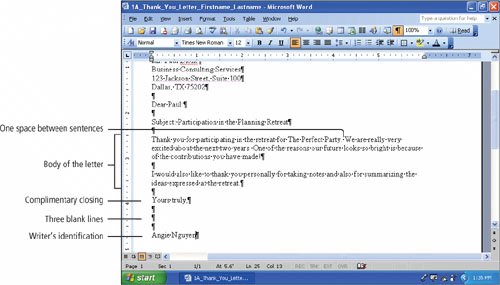
|
|
11. |
From the menu bar, display the File menu, and then click Page Setup. |
|
|
|
|
12. |
On the displayed Page Setup dialog box, click the Layout tab. Under Page, click the Vertical alignment arrow, and then click Center, as shown in Figure 1.13. Figure 1.13. 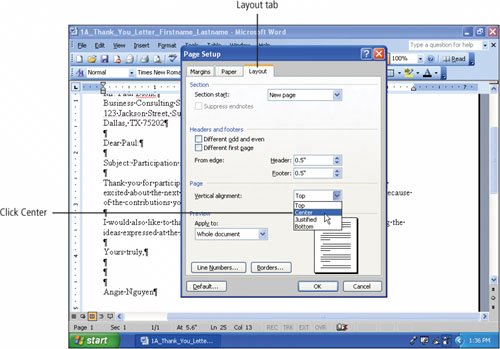
|
|
13. |
In the lower right corner of the Page Setup dialog box, click OK. |
|
14. |
On the Standard toolbar, click the Save button |
|
[Page 246 (continued)] Objective 2 Edit Text |
Windows XP
- Chapter One. Getting Started with Windows XP
- Project 1A. Windows XP
- Objective 1. Get Started with Windows XP
- Objective 2. Resize, Move, and Scroll Windows
- Objective 3. Maximize, Restore, Minimize, and Close a Window
- Objective 4. Create a New Folder
- Objective 5. Copy, Move, Rename, and Delete Files
- Objective 6. Find Files and Folders
- Objective 7. Compress Files
- Summary
- Key Terms
- Concepts Assessments
Outlook 2003
- Chapter One. Getting Started with Outlook 2003
- Getting Started with Microsoft Office Outlook 2003
- Project 1A. Exploring Outlook 2003
- Objective 1. Start and Navigate Outlook
- Objective 2. Read and Respond to E-mail
- Objective 3. Store Contact and Task Information
- Objective 4. Work with the Calendar
- Objective 5. Delete Outlook Information and Close Outlook
- Summary
- Key Terms
- Concepts Assessments
- Skill Assessments
- Performance Assessments
- Mastery Assessments
- Problem Solving
- GO! with Help
Internet Explorer
- Chapter One. Getting Started with Internet Explorer
- Getting Started with Internet Explorer 6.0
- Project 1A. College and Career Information
- Objective 1. Start Internet Explorer and Identify Screen Elements
- Objective 2. Navigate the Internet
- Objective 3. Create and Manage Favorites
- Objective 4. Search the Internet
- Objective 5. Save and Print Web Pages
- Summary
- Key Terms
- Concepts Assessments
- Skill Assessments
- Performance Assessments
- Mastery Assessments
- Problem Solving
Computer Concepts
- Chapter One. Basic Computer Concepts
- Objective 1. Define Computer and Identify the Four Basic Computing Functions
- Objective 2. Identify the Different Types of Computers
- Objective 3. Describe Hardware Devices and Their Uses
- Objective 4. Identify Types of Software and Their Uses
- Objective 5. Describe Networks and Define Network Terms
- Objective 6. Identify Safe Computing Practices
- Summary
- In this Chapter You Learned How to
- Key Terms
- Concepts Assessments
Word 2003
Chapter One. Creating Documents with Microsoft Word 2003
- Chapter One. Creating Documents with Microsoft Word 2003
- Getting Started with Microsoft Office Word 2003
- Project 1A. Thank You Letter
- Objective 1. Create and Save a New Document
- Objective 2. Edit Text
- Objective 3. Select, Delete, and Format Text
- Objective 4. Create Footers and Print Documents
- Project 1B. Party Themes
- Objective 5. Navigate the Word Window
- Objective 6. Add a Graphic to a Document
- Objective 7. Use the Spelling and Grammar Checker
- Objective 8. Preview and Print Documents, Close a Document, and Close Word
- Objective 9. Use the Microsoft Help System
- Summary
- Key Terms
- Concepts Assessments
- Skill Assessments
- Performance Assessments
- Mastery Assessments
- Problem Solving
- You and GO!
- Business Running Case
- GO! with Help
Chapter Two. Formatting and Organizing Text
- Formatting and Organizing Text
- Project 2A. Alaska Trip
- Objective 1. Change Document and Paragraph Layout
- Objective 2. Change and Reorganize Text
- Objective 3. Create and Modify Lists
- Project 2B. Research Paper
- Objective 4. Insert and Format Headers and Footers
- Objective 5. Insert Frequently Used Text
- Objective 6. Insert and Format References
- Summary
- Key Terms
- Concepts Assessments
- Skill Assessments
- Performance Assessments
- Mastery Assessments
- Problem Solving
- You and GO!
- Business Running Case
- GO! with Help
Chapter Three. Using Graphics and Tables
- Using Graphics and Tables
- Project 3A. Job Opportunities
- Objective 1. Insert and Modify Clip Art and Pictures
- Objective 2. Use the Drawing Toolbar
- Project 3B. Park Changes
- Objective 3. Set Tab Stops
- Objective 4. Create a Table
- Objective 5. Format a Table
- Objective 6. Create a Table from Existing Text
- Summary
- Key Terms
- Concepts Assessments
- Skill Assessments
- Performance Assessments
- Mastery Assessments
- Problem Solving
- You and GO!
- Business Running Case
- GO! with Help
Chapter Four. Using Special Document Formats, Columns, and Mail Merge
- Using Special Document Formats, Columns, and Mail Merge
- Project 4A. Garden Newsletter
- Objective 1. Create a Decorative Title
- Objective 2. Create Multicolumn Documents
- Objective 3. Add Special Paragraph Formatting
- Objective 4. Use Special Character Formats
- Project 4B. Water Matters
- Objective 5. Insert Hyperlinks
- Objective 6. Preview and Save a Document as a Web Page
- Project 4C. Recreation Ideas
- Objective 7. Locate Supporting Information
- Objective 8. Find Objects with the Select Browse Object Button
- Project 4D. Mailing Labels
- Objective 9. Create Labels Using the Mail Merge Wizard
- Summary
- Key Terms
- Concepts Assessments
- Skill Assessments
- Performance Assessments
- Mastery Assessments
- Problem Solving
- You and GO!
- Business Running Case
- GO! with Help
Excel 2003
Chapter One. Creating a Worksheet and Charting Data
- Creating a Worksheet and Charting Data
- Project 1A. Tableware
- Objective 1. Start Excel and Navigate a Workbook
- Objective 2. Select Parts of a Worksheet
- Objective 3. Enter and Edit Data in a Worksheet
- Objective 4. Construct a Formula and Use the Sum Function
- Objective 5. Format Data and Cells
- Objective 6. Chart Data
- Objective 7. Annotate a Chart
- Objective 8. Prepare a Worksheet for Printing
- Objective 9. Use the Excel Help System
- Project 1B. Gas Usage
- Objective 10. Open and Save an Existing Workbook
- Objective 11. Navigate and Rename Worksheets
- Objective 12. Enter Dates and Clear Formats
- Objective 13. Use a Summary Sheet
- Objective 14. Format Worksheets in a Workbook
- Summary
- Key Terms
- Concepts Assessments
- Skill Assessments
- Performance Assessments
- Mastery Assessments
- Problem Solving
- You and GO!
- Business Running Case
- GO! with Help
Chapter Two. Designing Effective Worksheets
- Designing Effective Worksheets
- Project 2A. Staff Schedule
- Objective 1. Use AutoFill to Fill a Pattern of Column and Row Titles
- Objective 2. Copy Text Using the Fill Handle
- Objective 3. Use AutoFormat
- Objective 4. View, Scroll, and Print Large Worksheets
- Project 2B. Inventory Value
- Objective 5. Design a Worksheet
- Objective 6. Copy Formulas
- Objective 7. Format Percents, Move Formulas, and Wrap Text
- Objective 8. Make Comparisons Using a Pie Chart
- Objective 9. Print a Chart on a Separate Worksheet
- Project 2C. Population Growth
- Objective 10. Design a Worksheet for What-If Analysis
- Objective 11. Perform What-If Analysis
- Objective 12. Compare Data with a Line Chart
- Summary
- Key Terms
- Concepts Assessments
- Skill Assessments
- Performance Assessments
- Mastery Assessments
- Problem Solving
- You and GO!
- Business Running Case
- GO! with Help
Chapter Three. Using Functions and Data Tables
- Using Functions and Data Tables
- Project 3A. Geography Lecture
- Objective 1. Use SUM, AVERAGE, MIN, and MAX Functions
- Objective 2. Use a Chart to Make Comparisons
- Project 3B. Lab Supervisors
- Objective 3. Use COUNTIF and IF Functions, and Apply Conditional Formatting
- Objective 4. Use a Date Function
- Project 3C. Loan Payment
- Objective 5. Use Financial Functions
- Objective 6. Use Goal Seek
- Objective 7. Create a Data Table
- Summary
- Key Terms
- Concepts Assessments
- Skill Assessments
- Performance Assessments
- Mastery Assessments
- Problem Solving
- You and GO!
- Business Running Case
- GO! with Help
Access 2003
Chapter One. Getting Started with Access Databases and Tables
- Getting Started with Access Databases and Tables
- Project 1A. Academic Departments
- Objective 1. Rename a Database
- Objective 2. Start Access, Open an Existing Database, and View Database Objects
- Project 1B. Fundraising
- Objective 3. Create a New Database
- Objective 4. Create a New Table
- Objective 5. Add Records to a Table
- Objective 6. Modify the Table Design
- Objective 7. Create Table Relationships
- Objective 8. Find and Edit Records in a Table
- Objective 9. Print a Table
- Objective 10. Close and Save a Database
- Objective 11. Use the Access Help System
- Summary
- Key Terms
- Concepts Assessments
- Skill Assessments
- Performance Assessments
- Mastery Assessments
- Problem Solving Assessments
- Problem Solving
- You and GO!
- Business Running Case
- GO! with Help
Chapter Two. Sort, Filter, and Query a Database
- Sort, Filter, and Query a Database
- Project 2A. Club Fundraiser
- Objective 1. Sort Records
- Objective 2. Filter Records
- Objective 3. Create a Select Query
- Objective 4. Open and Edit an Existing Query
- Objective 5. Sort Data in a Query
- Objective 6. Specify Text Criteria in a Query
- Objective 7. Print a Query
- Objective 8. Specify Numeric Criteria in a Query
- Objective 9. Use Compound Criteria
- Objective 10. Create a Query Based on More Than One Table
- Objective 11. Use Wildcards in a Query
- Objective 12. Use Calculated Fields in a Query
- Objective 13. Group Data and Calculate Statistics in a Query
- Summary
- Key Terms
- Concepts Assessments
- Skill Assessments
- Performance Assessments
- Mastery Assessments
- Problem Solving
- You and GO!
- Business Running Case
- GO! with Access Help
Chapter Three. Forms and Reports
- Forms and Reports
- Project 3A. Fundraiser
- Objective 1. Create an AutoForm
- Objective 2. Use a Form to Add and Delete Records
- Objective 3. Create a Form Using the Form Wizard
- Objective 4. Modify a Form
- Objective 5. Create an AutoReport
- Objective 6. Create a Report Using the Report Wizard
- Objective 7. Modify the Design of a Report
- Objective 8. Print a Report and Keep Data Together
- Summary
- Key Terms
- Concepts Assessments
- Skill Assessments
- Performance Assessments
- Mastery Assessments
- Problem Solving
- You and GO!
- Business Running Case
- GO! with Help
Powerpoint 2003
Chapter One. Getting Started with PowerPoint 2003
- Getting Started with PowerPoint 2003
- Project 1A. Expansion
- Objective 1. Start and Exit PowerPoint
- Objective 2. Edit a Presentation Using the Outline/Slides Pane
- Objective 3. Format and Edit a Presentation Using the Slide Pane
- Objective 4. View and Edit a Presentation in Slide Sorter View
- Objective 5. View a Slide Show
- Objective 6. Create Headers and Footers
- Objective 7. Print a Presentation
- Objective 8. Use PowerPoint Help
- Summary
- Key Terms
- Concepts Assessments
- Skill Assessments
- Performance Assessments
- Mastery Assessments
- Problem Solving
- You and GO!
- Business Running Case
- GO! with Help
Chapter Two. Creating a Presentation
- Creating a Presentation
- Project 2A. Teenagers
- Objective 1. Create a Presentation
- Objective 2. Modify Slides
- Project 2B. History
- Objective 3. Create a Presentation Using a Design Template
- Objective 4. Import Text from Word
- Objective 5. Move and Copy Text
- Summary
- Key Terms
- Concepts Assessments
- Skill Assessments
- Performance Assessments
- Mastery Assessments
- Problem Solving
- You and GO!
- Business Running Case
- GO! with Help
Chapter Three. Formatting a Presentation
- Project 3A. Emergency
- Objective 1. Format Slide Text
- Objective 2. Modify Placeholders
- Objective 3. Modify Slide Master Elements
- Objective 4. Insert Clip Art
- Project 3B. Volunteers
- Objective 5. Apply Bullets and Numbering
- Objective 6. Customize a Color Scheme
- Objective 7. Modify the Slide Background
- Objective 8. Apply an Animation Scheme
- Summary
- Key Terms
- Concepts Assessments
- Skill Assessments
- Performance Assessments
- Mastery Assessments
- Problem Solving
- You and GO!
- Business Running Case
- GO! with Help
Integrated Projects
Chapter One. Using Access Data with Other Office Applications
- Chapter One. Using Access Data with Other Office Applications
- Introduction
- Project 1A. Meeting Slides
- Objective 1. Export Access Data to Excel
- Objective 2. Create a Formula in Excel
- Objective 3. Create a Chart in Excel
- Objective 4. Copy Access Data into a Word Document
- Objective 5. Copy Excel Data into a Word Document
- Objective 6. Insert an Excel Chart into a PowerPoint Presentation
Chapter Two. Using Tables in Word and Excel
- Chapter Two. Using Tables in Word and Excel
- Introduction
- Project 2A. Meeting Notes
- Objective 1. Plan a Table in Word
- Objective 2. Enter Data and Format a Table in Word
- Objective 3. Create a Table in Word from Excel Data
- Objective 4. Create Excel Worksheet Data from a Word Table
Chapter Three. Using Excel as a Data Source in a Mail Merge
- Chapter Three. Using Excel as a Data Source in a Mail Merge
- Introduction
- Project 3A. Mailing Labels
- Objective 1. Prepare a Mail Merge Document as Mailing Labels
- Objective 2. Choose an Excel Worksheet as a Data Source
- Objective 3. Produce and Save Merged Mailing Labels
- Objective 4. Open a Saved Main Document for Mail Merge
Chapter Four. Linking Data in Office Documents
- Chapter Four. Linking Data in Office Documents
- Introduction
- Project 4A. Weekly Sales
- Objective 1. Insert and Link in Word an Excel Object
- Objective 2. Format an Object in Word
- Objective 3. Open a Word Document That Includes a Linked Object, and Update Links
Chapter Five. Creating Presentation Content from Office Documents
EAN: 2147483647
Pages: 448
 .
. . If the Standard and Formatting toolbars are on two separate rows as shown in Figure 1.3, move the pointer into the Word document window and click to close the list without making any changes. If the toolbars share a single row, click Show Buttons on Two Rows.
. If the Standard and Formatting toolbars are on two separate rows as shown in Figure 1.3, move the pointer into the Word document window and click to close the list without making any changes. If the toolbars share a single row, click Show Buttons on Two Rows. in the upper right corner of the task pane.
in the upper right corner of the task pane. .
. to display the formatting marks.
to display the formatting marks. . In the displayed New Folder dialog box, in the Name box, type Word Chapter 1 as shown in Figure 1.10, and then click OK.
. In the displayed New Folder dialog box, in the Name box, type Word Chapter 1 as shown in Figure 1.10, and then click OK. to save the changes that you have made to the letter since your last save operation.
to save the changes that you have made to the letter since your last save operation.